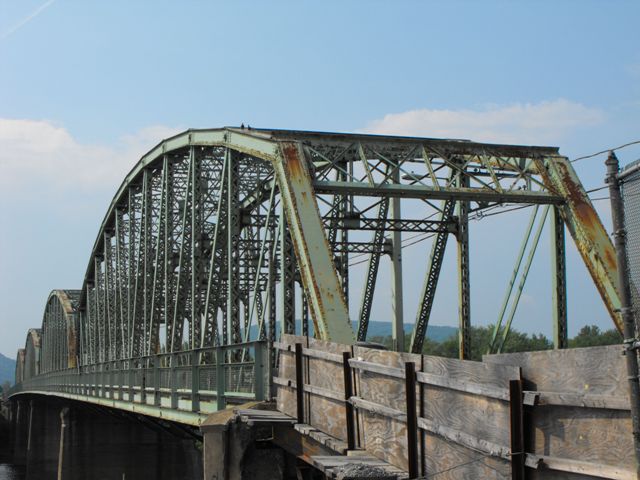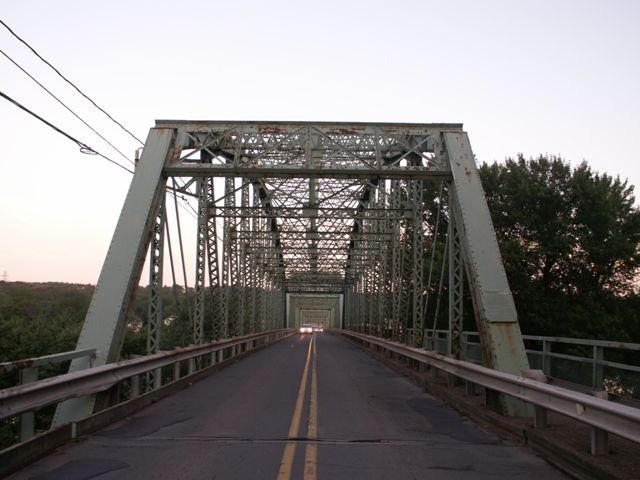We Recommend:
Bach Steel - Experts at historic truss bridge restoration.
Wyoming Bridge
8th Street Bridge

Primary Photographer(s): Nathan Holth and Rick McOmber
Bridge Documented: July 14, 2008 and 2010
Wyoming: Luzerne County, Pennsylvania: United States
Metal 12 Panel Pin-Connected Parker Through Truss, Fixed and Approach Spans: Metal Continuous Stringer (Multi-Beam), Fixed
1914 By Builder/Contractor: Penn Bridge Company of Beaver Falls, Pennsylvania and Engineer/Design: David A. Keefe of Athens, Pennsylvania
1950
228.0 Feet (69.5 Meters)
1,311.0 Feet (399.6 Meters)
19 Feet (5.79 Meters)
4 Main Span(s) and 9 Approach Span(s)
40102100100126

View Information About HSR Ratings
Bridge Documentation
This bridge no longer exists!
View Archived National Bridge Inventory Report - Has Additional Details and Evaluation
This historic bridge was demolished by PennDOT July 7th, 2011 at 12:02 PM!
About This Bridge
This bridge is a large four span pin-connected Parker truss bridge that includes a series of steel stringer approach spans. The bridge was built by the prominent Pennsylvania-based Penn Bridge Company. It is historically significant as a representative example of a late pin-connected truss bridge, and also as a large, multi-span example of a pin-connected truss bridge. Although there is another example in Luzerne County, there are very few remaining examples of large multi-span pin-connected truss bridges on a statewide basis. The high level of historic value and the preservation of each remaining example should be realized, but unfortunately is not.
Wyoming Bridge: Yet Another Doomed Pennsylvania Bridge
Once again as it has so many times before, PennDOT is practicing one of the most wasteful and frustrating things that could be done with historic bridges. PennDOT is replacing this bridge with a new bridge on a new alignment, and even though the historic bridge is not in the way of its replacement, and would likely remain standing in place for decades to come if abandoned in its current condition, they still will choose to waste taxpayer dollars on demolishing this bridge. This is a pointless waste not only of a, beautiful historic bridge but also a waste of taxpayer dollars. The historic Wyoming Bridge could and should be left in place next to its replacement. If an when funding developed for a full restoration project, a linear park could be created on the bridge, with benches, picnic tables, interpretive signage, etc on half of the bridge's width, and the other half could hold a non-motorized travel facility. Such a restoration project would create a focal point for Wyoming for residents and visitors to enjoy the beautiful Susquehanna River, which is one of the most noteworthy natural features of the Commonwealth.
Unfortunately, PennDOT chose to demolish the bridge regardless of preservation options available. Demolition video is available here.
PennDOT's 100 Year Bridge Life: Something New?
PennDOT made a claim in a local news article and video piece that the new bridge would be different from the old bridge because the new bridge was designed to last 100 years. They claimed that this was something new engineers and PennDOT had developed called a "100 Year Bridge Life" program and in effect they appeared to be claiming that old bridges were not engineered and built to last 100 years. This is absolutely and completely untrue. The existing historic Wyoming Bridge and truss bridges across the country built from the 1800s through perhaps the 1940s were absolutely designed to last 100 years or more. It may be true that bridges built from 1960 and after were not built to last as long because they are being replaced at a surprising rate these days. But to claim that the development of a "100 Year Life" bridge is something new is insulting to the engineers and craftsman who diligently designed, fabricated and erected the structures that are today's historic bridges, because those have indeed lasted well over 100 years and would last longer if they were preserved and maintained properly. The Wyoming 8th Street Bridge was certainly designed to last 100 years and beyond. If it did not, it was likely due to a lack of maintenance. The Glen Gardner Bridge, which was built in 1870 and has lasted 140 years (and without any retrofit or alterations) and indeed still has hardly a scratch on it. The Glen Gardner Bridge is a quintessential example of how long a bridge can last with proper maintenance.
Another frustrating claim that PennDOT made in the aforementioned news and publicity event was that PennDOT intended to prevent their new bridges from becoming deteriorated by engaging in routine maintenance. This would be great if this commitment extended to all bridges and not just ugly new bridges. However as far as HistoricBridges.org is aware, this commitment to maintenance does not extend to historic bridges. HistoricBridges.org and other preservationists have often approached PennDOT and asked them to do just this with historic truss bridges and they still do not engage in such routine maintenance. If they can do it with new bridges, why not with the old historic bridges? Common activities like spot-painting the historic truss bridges to prevent section loss before it has a chance to develop, and washing the historic truss bridge to get the moisture-trapping dirt out of the bottom chord are examples of things that PennDOT rarely if ever does for the historic truss bridges of the Commonwealth.
Historic Significance
This bridge is a pin-connected truss bridge, and an extremely large multi-span example. Thanks to PennDOT it is also an extremely rare bridge type in Pennsylvania today. The Susquehanna River used to be teeming with large multi-span truss bridges, both riveted and pinned, but they have been being demolished at a rapid rate. The Pennsylvania Historic Bridge Inventory dismissed nearly all pin-connected truss bridges built after 1910 as not historic and not eligible for the National Register of Historic Places, regardless of integrity, size, or construction date. Given the rate of demolition and reduction of surviving examples of this bridge type, HistoricBridges.org strongly disagrees with this finding. Indeed, the fact that any truss bridge over 50 years old of this size would be considered not historic is ridiculous considering the fact that the bridge type has largely been considered archaic by engineers for decades now. Further, any truss bridge with pinned connections, including late examples, that has decent historic integrity should be considered historic. The position of the Pennsylvania Historic Bridge Inventory is outdated and further disproved by the fact that other states and other historic resource consultants found similar bridges eligible in other states. The Pennsylvania historic bridge inventory operates on the philosophy that historic significant arises only from innovative, prototypical engineering, and that significance does not arise from good representative examples of structures from a period in history. This appears to go against the philosophy of the National Register of Historic Places which has accepted structures from both categories in other states. The information below from the Historic Bridge Inventory is provided for structure information and reference only. HistoricBridges.org does not agree with the findings of the below historic bridge inventory assessment.
Information and Findings From Pennsylvania's Historic Bridge InventoryDiscussion of Bridge The 13 span, 1,311'-long bridge built in 1914 has 4 pin-connected, steel Parker thru truss spans (4 @ 228') over the stream, and 9 steel stringer approach spans (8@ 54', 1 @ 15') over the flood plain. The bridge with cantilevered sidewalk is supported on concrete cutwater piers and abutments. The truss spans have built-up upper chords, diagonals, and verticals of standard steel sections. The lower chords are eye bars. Built up floorbeams are placed above the lower chord pins and support steel stringers and a concrete-filled steel grid deck. Welded angle and channel railings replaced earlier railings ca. 1950. The Parker truss, a variation of the Pratt truss with polygonal top chord, was developed about 1870 by American engineer Charles H. Parker. Like the Pratt truss, most pre-1900 examples were pin-connected because of the simplicity of design and economy of fabrication and erection. After 1900, rivet-connected Parker truss bridges were increasingly popular, although pin connected examples, such as this bridge, continued to be built. The bridge is a late and undistinguished example of its type and design with no unusual or distinctive features. It is not historically or technologically distinguished by its setting or context. Discussion of Surrounding Area The bridge carries a 2 lane road with a sidewalk over a stream and flood plain in a setting dominated by late 20th century commercial development. At the north end is a shopping center. At the south end is a garage and restaurant. The setting does not have the cohesiveness or integrity of a historic district. Bridge Considered Historic By Survey: No |
![]()
Photo Galleries and Videos: Wyoming Bridge
2008 Bridge Photo-Documentation
Original / Full Size PhotosA collection of overview and detail photos. Includes views of the plaque. This gallery offers photos in the highest available resolution and file size in a touch-friendly popup viewer.
Alternatively, Browse Without Using Viewer
![]()
2008 Bridge Photo-Documentation
Mobile Optimized PhotosA collection of overview and detail photos. Includes views of the plaque. This gallery features data-friendly, fast-loading photos in a touch-friendly popup viewer.
Alternatively, Browse Without Using Viewer
![]()
2010 Sunny Day Visit
Original / Full Size PhotosA collection of overview photos, as well as a few additional detail photos. This gallery offers photos in the highest available resolution and file size in a touch-friendly popup viewer.
Alternatively, Browse Without Using Viewer
![]()
2010 Sunny Day Visit
Mobile Optimized PhotosA collection of overview photos, as well as a few additional detail photos. This gallery features data-friendly, fast-loading photos in a touch-friendly popup viewer.
Alternatively, Browse Without Using Viewer
![]()
Northbound Crossing of the Bridge
Full Motion VideoStreaming video of the bridge. Also includes a higher quality downloadable video for greater clarity or offline viewing.
![]()
Southbound Crossing of the Bridge
Full Motion VideoStreaming video of the bridge. Also includes a higher quality downloadable video for greater clarity or offline viewing.
![]()
Maps and Links: Wyoming Bridge
This historic bridge has been demolished. This map is shown for reference purposes only.
Coordinates (Latitude, Longitude):
Search For Additional Bridge Listings:
Bridgehunter.com: View listed bridges within 0.5 miles (0.8 kilometers) of this bridge.
Bridgehunter.com: View listed bridges within 10 miles (16 kilometers) of this bridge.
Additional Maps:
Google Streetview (If Available)
GeoHack (Additional Links and Coordinates)
Apple Maps (Via DuckDuckGo Search)
Apple Maps (Apple devices only)
Android: Open Location In Your Map or GPS App
Flickr Gallery (Find Nearby Photos)
Wikimedia Commons (Find Nearby Photos)
Directions Via Sygic For Android
Directions Via Sygic For iOS and Android Dolphin Browser
USGS National Map (United States Only)
Historical USGS Topo Maps (United States Only)
Historic Aerials (United States Only)
CalTopo Maps (United States Only)



